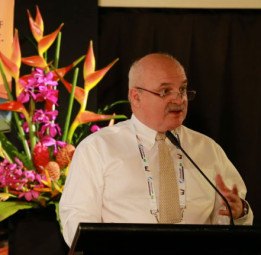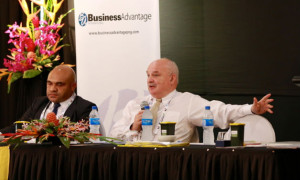
Oil Search CEO Peter Botten. Credit: Stephen Rae
There is enough gas capacity in PNG for at least three more LNG trains over the next five-to-seven years, according to Oil Search CEO, Peter Botten, who’s called for gas developers to co-operate and share facilities.
Papua New Guinea is at ‘the crossroads’ for gas commercialisation, Peter Botten has told the 2014 Papua New Guinea Advantage Investment & Infrastructure Summit in Port Moresby, as he laid out his argument for a co-operative approach to developing the new gas projects, including his own company, Oil Search.
Significant reserves have already been discovered in PNG, he said, which will require building at least three new trains (or gas processing plants) over the next five to seven years, at a cost of somewhere between US25-$28 billion.
Admitting PNG had been good for Oil Search, returning 754 per cent in shareholder returns over the last 10 years, Botten said it was a tribute to relative political and fiscal stability.
Likely finds
‘Our belief is that out in the Gulf and in the Highlands, three more trains is very likely and that’s our base business plan to deliver over the next five to seven years, leveraging as much as possible the infrastructure as we have out there.
Significant reserves have already been discovered in PNG, which will require building at least three new trains (or gas processing plants) over the next five to seven years, at a cost of somewhere between US25-$28 billion.
Hides is the largest field in PNG, although more reserves could be found in the Elk-Antelope field in the next few months.
Analysts had predicted a further five billion barrels equivalent of oil could be found – about 30 tcf of gas.
Oil Search has about 12 tcf of gas in its portfolio, and just under another 4 tcf may be available to Oil Search.
The amount of proven and undeveloped gas totals about 14 tcfs. The first PNGLNG plant contains nine tcf.
‘You can actually see we actually already have the basis for a significant expansion of LNG business in this country.’
Lower prices
The next six months is critical for understanding the amount of reserves, how to get them out and how to build each energy trains, he said. And the next 12-18 months will be critical to have confirmation from the national government that the fiscal regime will be stable, landowner agreements and the regulatory regime.
‘… so we look at the market over the next five to seven years it’s a much more difficult place to be and we’re probably not going to achieve quite the same pricing that PNG LNG One and Two did.’
But he also warned the price of LNG may not be as high as the current contract for the first LNG plant output.
‘The LNG customers believe they have a lot more choice in the market, for various suppliers from from North America, from East Africa, and others, so we look at the market over the next five to seven years it’s a much more difficult place to be and we’re probably not going to achieve quite the same pricing that PNG LNG One and Two did.’

Oil Search’s Peter Botten (right) with National Petroleum Company MD, Wapu Sonk. Credit: Stephen Rae
But he said, PNG now has an established reputation as a supplier.
The fact the first LNG plant had been built on time and within a revised Budget, had built substantial infrastructure like airfields and camps, and had sold almost all the gas to ‘quality’ buyers, would bode well when it comes time to finance the next three trains, he said.
Lessons from Australia
Referring to the Curtis Island LNG development in Gladstone in Queensland in northern Australia, Botten pointed out there have been three separate LNG developments, built at the same, ‘with almost no connection, or co-operation between the three projects’.
That lack of co-ordination between gas developers will be costly and inefficient, with the government-as the only entity to be a shareholder in each gas development company-being the biggest loser.
Of the A$70 billion spent on the three plants, Botten said analysts have estimated A$10–A$15 billion could have been saved if the operators had spoken to each other and not built ‘three lots of tanks, three lots of jetties, three lots of camps, all of which duplicate capital, all of which reduce the speed to market and all which reduce shareholder value across all three projects’.
‘What we don’t want to do in PNG is to have that lack of co-ordination in any new development across any energy business that we have up here.’
That lack of co-ordination between gas developers will be costly and inefficient, with the government—as the only entity to be a shareholder in each gas development company—being the biggest loser.








Speak Your Mind